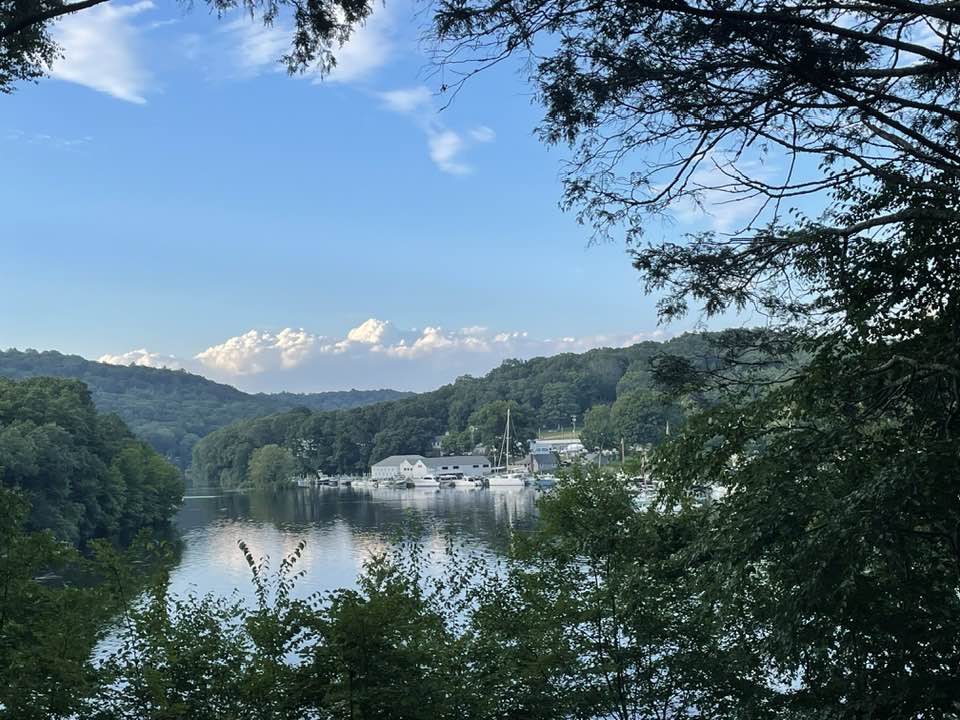AUGUST 29, 2024 – (Cont.) Mother and UB—the last of their generation in our family—died within two months of each other in the first half of 2017. In August of that year my sisters and I and two members of the next generation gathered for three days at Lyme Light. It was the first time that my sisters and I had been there together. Our main mission was to release our elders’ co-mingled ashes into the cove waters, but we pursued other classic activities, as well: Scrabble games, conversation, walks to Elys Ferry Landing, and going out to dinner. During “down times” I couldn’t resist two additional diversions: cleaning out the rain gutters and trimming the tangle of vegetation that had taken over the steep bank out front.
One vine variety, I remember, had sent a tentacle twisting straight up into the air searching blindly for an invisible trellis linking earth to sky. The aspiring vine had lots of company aiming to obscure our splendid view of the cove. Poison ivy and the almost vertical pitch of the bank precluded access much beyond the edge of the lawn at the top of the bank. I resorted to buying a pole saw to extend my reach and worked for hours to clear the brush without sliding downhill 40 feet into the water or winding up covered with a poison ivy rash. After a three-day stay it was time to head back to Minnesota.
During the summer of 2020 when the country was in Covid lock-down, my wife and I took a road trip to Lyme Light to visit there our son and future daughter-in-law. Able to work remotely, they’d sought refuge from life in the city. With few on-site diversions and nowhere off-site to go, I wandered the property to scope out pruning and beautification opportunities. In the thick blanket of vines, the shrubs that had become trees, and trees that had grown into monstrosities, I discovered a connection with my great-grandfather that I’d never felt before. A year or two before I’d uncovered a mahogany framed set of early photographs of the place in its prime. The contrast between the current jungle and the well-kempt past stirred my desire to restore a part of our great-grandfather’s masterpiece to its former state—or at the very least, cut back some growth here and there. With sweat constantly dripping off my brow, I treated my efforts as commemoration of a century’s worth of unchecked growth and my elders’ neglect of the property.
I slashed and dragged multiple loads of trimmings from one end of the property to the top of the bank and hurled them over the edge. It would’ve been cathartic, except that for every load I dragged and hurled, a dozen more seemed to await me. I was engaged in the classic Sisyphean effort and had little to show for it except fatigue.
During visits in subsequent years, I continued my obsessional entanglement with our property’s over-growth. Emblematic of the futility of my work was—and persistently is—an invasive fast-growing broad-leaf weed-tree. At some point it sprang forth spontaneously from a small flower garden that my sister Jenny had cultivated within sight of the front veranda. When my wife, granddaughter and I arrived for a visit in late June last year, the weed-tree was 16 feet tall and consisted of five or six leafy stalks or trunks. I cut down the green monster and pitched the whole thing over the bank. When we returned this past June, the multi-trunk weed-tree had reappeared and was already 10 feet high. Again, I severed the trunks from their base and threw the unwanted vegetation over the bank. In just two months, the ridiculous weed-tree was yet again dominating the garden, and again, I chopped it down and threw it away—way over the bank.
When my wife and I arrived back on-site a week ago, the damn weed-tree was back in action—but so was I: over the bank it went.
But something else occurred this time around, inspired by the long-anticipated visit by a long-lost cousin Carol and her husband Barry. Carol had last appeared on the cove as a young child over a half century ago. She was not so much a “lost” cousin as she was “estranged,” though however my sisters and I might characterize Carol, she (and her brother and two sisters—their family being a mirror-image of ours) could do the same regarding my sisters and me. George B. Holman, the grand patriarch, was the great-grandfather of us all, and our long-awaited reunion would occur at the paradise he’d created well over a century ago.
To highlight the occasion, I decided to tackle the 300-foot boundary hedge—or at least a significant section of it. I would chop, cut, prune, trim and slash as much as possible, all in preparation for our cousin and her husband’s arrival. (Cont.)
Subscribe to this blog and receive notifications of new posts by email.
© 2024 by Eric Nilsson
